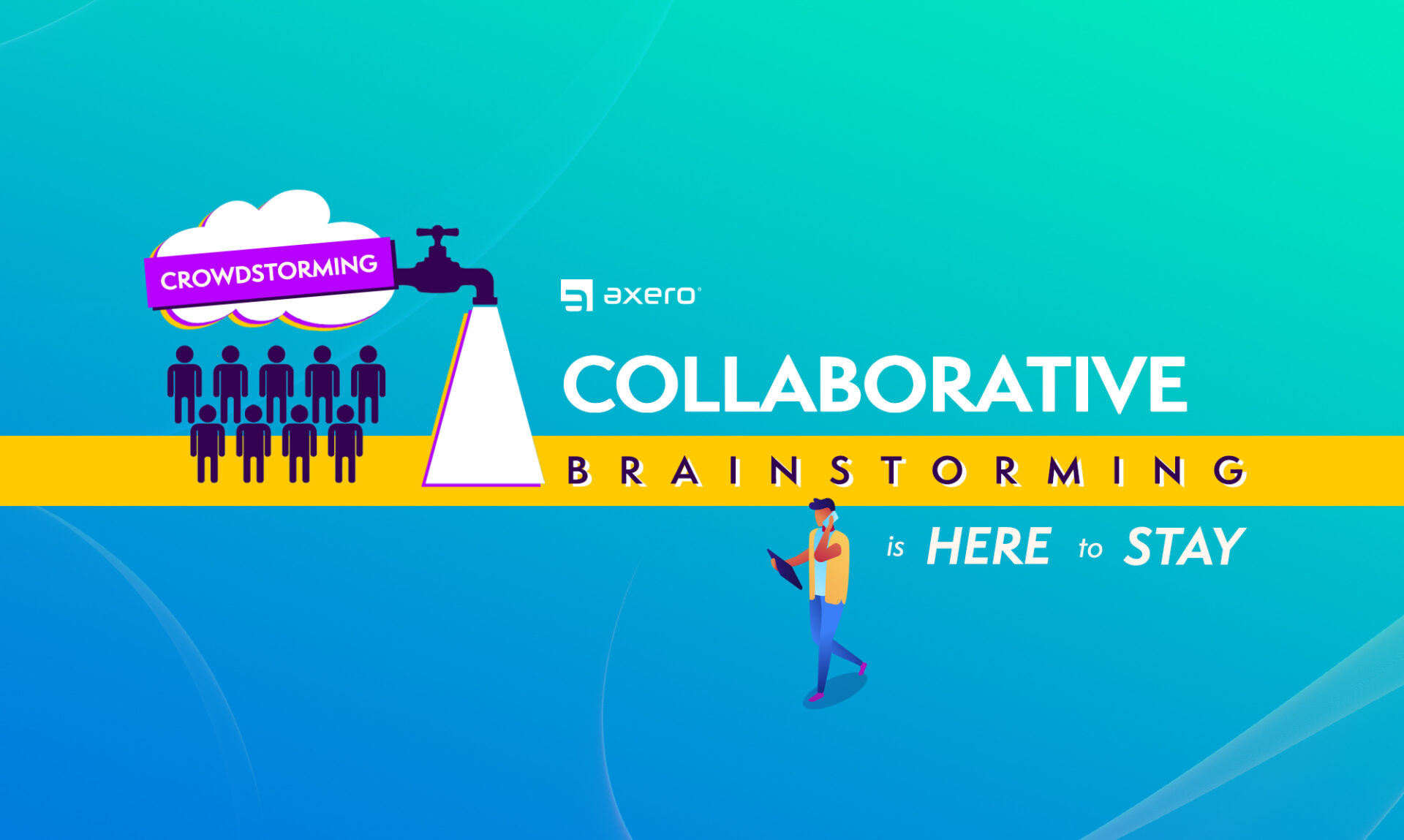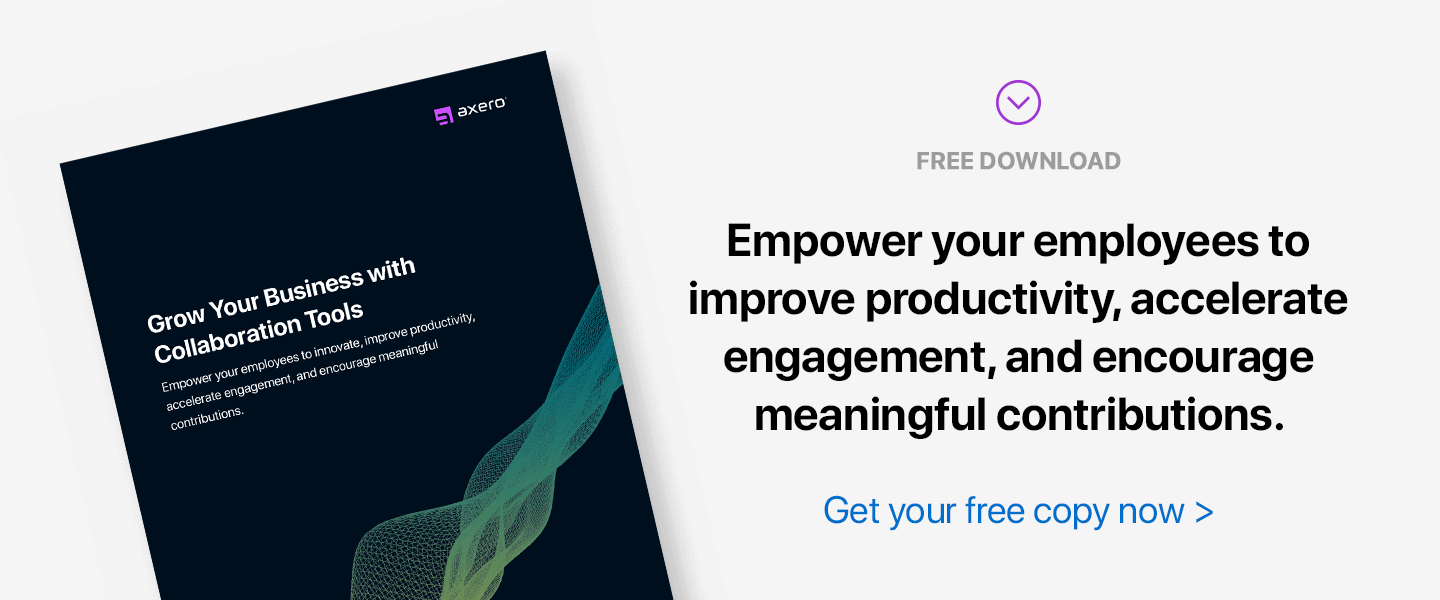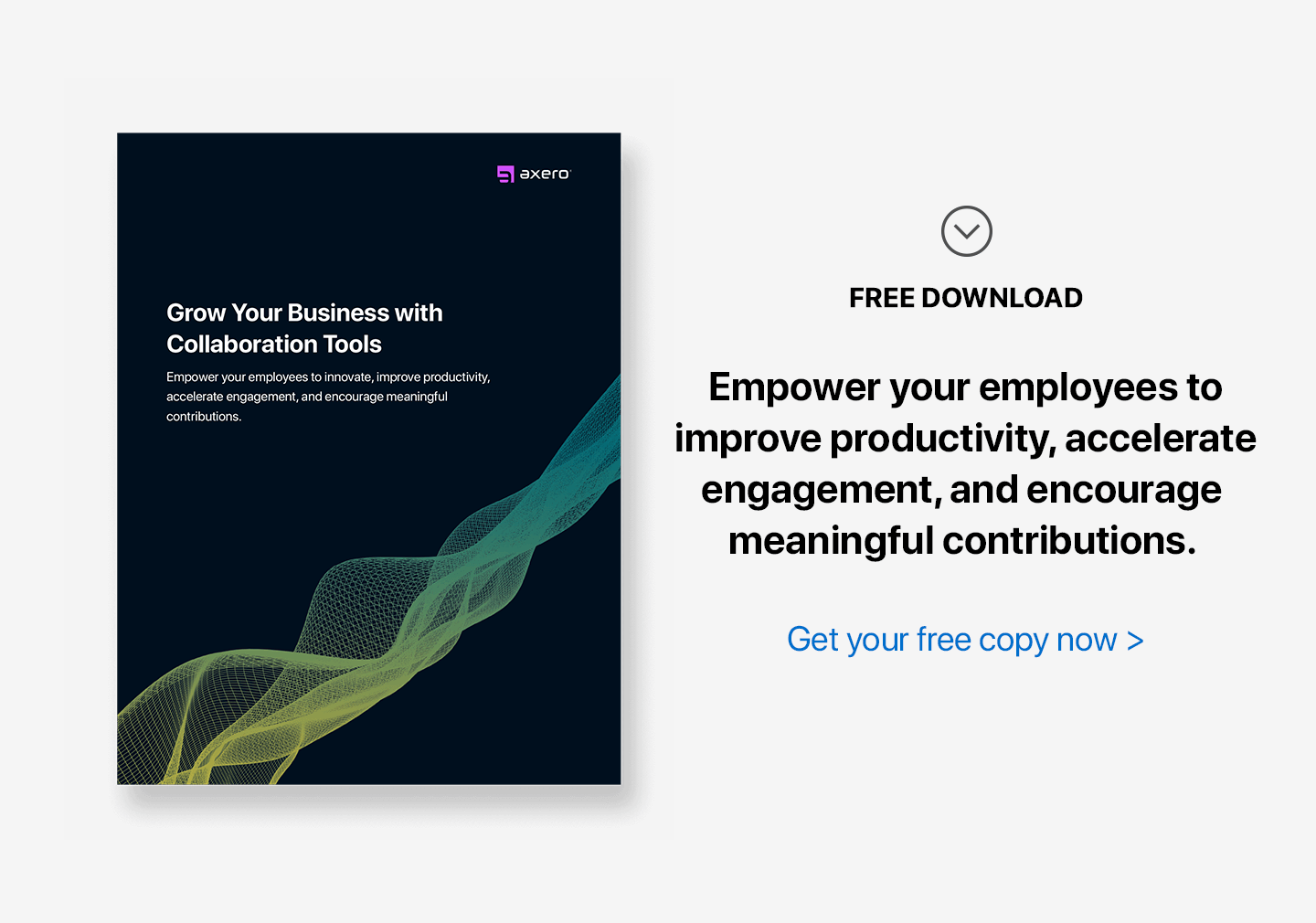Brainstorming is one of the most effective ways for people to problem solve, generate ideation across teams, and innovate.
It’s a method of processing and creating information that is as old as the hills, and for good reason — it simply works.
Technology, like team collaboration software, has made it easier to collaborate with others, share ideas on a large scale, and create a proactive community. In the age of information, we call this method for solving problem “crowdstorming.”
What is crowdstorming?
Crowdstorming is a massive collaborative brainstorming session with a large community of people. With crowdstorming, you tap into ideation—or the collection of ideas from a group of people—and leverage it to solve a specific issue.
The “brainstorming” element is crucial here, because professionals who turn to crowdstorming usually have a problem that needs to be solved. It can be viewed as a collaborative method for fixing an issue or preparing a product/service for launch.
What is crowdsourcing?
Crowdsourcing is the process of getting outside opinions from a large population of people. Think company products or service feedback.
It’s a great method for gaining insight into what is working and identifying trends in your market. The internet and vast technological advancements have made it incredibly easy for consumers to post comments and find reviews about practically anything. Businesses can get a lot of mileage by paying attention—and technology has made it easier to launch crowdsourcing campaigns.
Before crowdstorming, there was crowdsourcing. And before that, there was brainstorming.
Elements of crowdstorming have been around for a while, but the process (and term) itself is relatively new.
For many years, in-house brainstorming was the secret weapon for many businesses. A challenge would present itself, and an individual or team in an organization would sit down to outline any/all potential solutions.
Collaborative brainstorming can be a very organic and effective process. There are, however, some cases that require external perspectives to reach the end goal.
Enter crowdsourcing.
When crowdsourcing became a bigger trend for business development and customer retention, many looked at it as a happy accident. Companies turned to the internet to find unbiased opinions about their products and services to streamline future projects and improve product development.
Some businesses would actively seek consumers for their opinions, while others would take note of comments posted without their intervention.
Crowdsourcing added a major “social” element to the business landscape, allowing companies and consumers to interact in ways that were never before possible.
If you’re confused about the differences between brainstorming and crowdsourcing—it’s okay! These two concepts both lean on ideation and collaboration to problem solve. The difference is who your audience is. And with crowdstorming, you get the best of both worlds.
This makes crowdstorming one of the most modern business communication trends and forward-thinking ways to tackle a difficult situation. Here’s how to harness its power.
Types of crowdstorming.
There are a few ways to approach crowdstorming. A good place to start is to look at what the end goal is. Think of what the task is that you’re asking a crowd to participate in.
The first type of crowdstorming is used for generating ideation, which could include plans for a marketing campaign or ideas for developing new prototypes. Typically, a specific community or the general public are the target audience for gaining this information from — remember that targeting isn’t necessarily “better” than looking to the general public for ideas.
Secondly, on a more complex level, there may be additional tasks associated with crowdstorming. At this stage in the collaborative brainstorming process, a second or third group may be tasked with rating and evaluating a set of ideas created by the first group. More often than not, companies that embrace crowdstorming end up at this point in the process when looking to develop a new product or service, as extra levels of validation can help to ensure that a launch is successful.
And the third most common type of crowdstorming is perhaps the most complex of all, thanks to the fact that the crowd is responsible for nearly every aspect of the process. In some scenarios, there are no means other than turning to crowds when attempting to source feedback or ideas. This is a common situation that happens with start-ups, as they don’t usually have the same resources to go off of that an established business might. Even though there is more room for error the more complex a crowdstorming project gets, true magic can happen when everything comes together at this level.
Internal vs. external crowdstorming.
Most people assume crowdstorming pertains to outside parties, like customers. While that is true, crowdstorming can also be conducted internally.
In external crowdstorming, the public (or a targeted subset) is asked to submit ideas, feedback, or anything else that might be helpful to a company. External crowdstorming is a great option for identifying trends in the market or understanding your ideal customer better, while also building deeper relationships and brand awareness.
With internal crowdstorming, a firm can tap into the minds of the entire organization, or specific groups of people associated with the organization. This can be employees from a different division, location, or tying in vendors and suppliers. Internal crowdstorming allows you to collect information from the people who understand your business the best: your employees.
The most important difference between internal and external crowdstorming is internal crowdstorming focuses a crowd that is well-known to the company conducting the research. It could come in a variety of forms, ranging from simple questions to employees from management (in which answers would be aggregated) to a dedicated portal specifically for the submission of ideas and feedback.
Familiarity with an organization can be both a blessing and a curse when it comes to crowdstorming, which is why the most effective method for receiving ideas and information from a crowd is to take both an internal and an external approach, combining and analyzing the results of each method.
Crowdstorming and collaborative brainstorming in popular culture. The good, the bad, and the ugly.
Sometimes, the best way to go about understanding a new concept, like crowdstorming, is to take a look at how and where it fits into popular culture.
Taking just the last few years into consideration, there are a variety of different examples of crowdstorming that are worth analyzing, some of which have been more effective than others.
~ The Good ~
Take a look at American Idol, for example. The show employs crowdstorming on a multitude of levels. It not only discovers and promotes new talent, but it also develops relationships between the viewers and the contestants. What makes American Idol a brilliant employment of crowdstorming, is that most people are not even aware that they are crowdsourcing.
GE’s Ecomagination project is another great example of crowdstorming. GE encourages consumers to contribute ideas and knowledge to help reduce the company’s environmental impact. It’s a “win-win” situation that is turning a lot of heads, and for good reason.
~ The Bad ~
On the other side of the spectrum are examples of crowdstorming in popular culture that haven’t been quite as effective, most notably the public-sourced “naming contests.”
NASA held an online public vote, to crowdstorm / crowdsource a name for a new room in the international space station. So what happened? Comedian Stephen Colbert convinced his fans to write in his name. And guess what? He won. The room was ultimately not named after Colbert—a NASA spokesman said that, “the name Colbert doesn’t quite fit with the NASA theme.” An example of a not-so-good attempt at collaborative brainstorming.
~ The Ugly ~
Mountain Dew held a crowdsourcing campaign to name a new flavor of soda. They allowed people to type in names, hit a submit button, and the names appeared in a rated order on the website. It didn’t take long before the campaign was hijacked and spammed with names that were not so “family friendly.” Mountain Dew accepted defeat and publicly stated that “Dub the Dew definitely lost to the Internet.”
Now, there’s a reason the “naming contests” are a dying breed, and it simply comes down to poor organization, little planning, and the underlying factors that motivate them.
Crowdstorming is best used as a method for solving a problem, yet “naming contests” are typically geared towards building conversation and engagement. As a result, such contests often end in failures, most often due to a lack of guidance and no true centralized goal for people to get on-board with.
Tips for implementing crowdstorming and collaborative brainstorming you can use today.
Once you get a basic handle on crowdstorming, it’s important to take a methodical approach to implementing and strategizing your collaborative brainstorming project.
For those who have never carried out a crowdstorming campaign before, here’s some helpful tips to get you started.
- Clarify your question / problem – Every solution starts with a problem, which is why crowdstorming exists in the first place. Identify the question or problem first. This will help streamline your collaborative brainstorming campaign and make it easier for a crowd to offer ideas and feedback. If your pool of individuals do not understand the issue, they will not have an effective way to provide feedback.
- Come up with a reward – In some cases, you might be lucky to have a pool of individuals who are willing to provide feedback without expecting anything. In most cases, you’ll have a much better chance of eliciting great ideas if there is a reward for candidates with the best input. This can range from gift cards to swag bags, and the “right” reward will depend upon your industry, the crowd you poll and other factors. Make the reward known ahead of time whenever possible.
- Choose your collaboration software – We have you covered here with our Axero platform (shameless plug). However, there are many other options out there if you do a simple google search.
- Recruit your crowd – Be selective when recruiting a crowd. It could be super diverse, like general public, which works great for large firms. Smaller companies, may want to start out with internal crowdstorming, or a targeted subset of the community. Every type of crowd will elicit a different type of response, so keep this in mind when choosing a group.
- Narrow it down – Once you’ve been inundated with ideas and information, take the time to sort through it all and determine which ideas are the most viable. This can be a time-consuming process, but there’s nothing more important than delivering on your promises and following the process through to the very end. Consider creating a project group to filter through responses—it can be overwhelming!
- Deliver the goods – The key to an effective crowdstorming campaign comes in at the end of the process. If you ever wish to work with a crowd again, you’ve got to deliver on the promises you’ve made. This means more than simply giving up those rewards you set in place early on, however — you’ve got to bring the ideas that you’ve chosen to life. If a crowdstorming campaign fails, it’s typically because the products, services or plans discussed throughout the process don’t actually get put into action, which basically means the entire collaborative brainstorming campaign was a waste of time, energy, and money. Whatever you do, do not allow your business to fall into this category.
Crowdstorming and intranet software.
Intranet software is one of the most effective technological developments to impact the professional world. It allows firms to communicate not only internally, but externally with customers and partners.
Since it can be used as a platform for customer support, it should come as no surprise that this type of software can also serve as an excellent platform for businesses that are looking to conduct a crowdstorming or ideation campaign.
Modern intranet software works best for crowdstorming when used on a targeted level, where a business might invite a specific subset of individuals to join an online community and share ideas and feedback.
The beauty of using intranet software for this reason is that it allows people to communicate back and forth with one another, creating a true conversation rather than a collection of random ideas. Because new ideas can come from dialogue, the process can be expedited, saving money for the organization and time for the crowd being polled.
Results are typically higher in quality, less “all over the map” and, in the end, more viable than those gained from other crowdstorming methods.
The future of crowdstorming and collaborative brainstorming.
It’s fair to assume that crowdstorming has a bright future in the business community at large.
Technology has made it exceptionally easy to poll a crowd and gain outside information, and as options like social intranet software become more of a necessity, crowdstorming will only get easier.
It’s likely that it will also take a turn towards a more ratings-based system, not unlike that associated with credit scores, which so many people are already familiar with. A more effective, perhaps centralized rating system will help to quantify results and save you time.
Even more exciting is the opportunity for crowdstorming to shift in a slightly different direction than it is moving in today.
While it’s an excellent way to source information and feedback, there is a great deal of potential in crowdstorming for bringing together a team of experts to find the solution to a particular problem. Crowdstorming can extend far beyond the realm of business — it could change the way we approach problems as large as health conditions. (Here’s how AiArthritis uses Axero to connect health professionals and advocates!)
There’s a lot to take into consideration when exploring crowdstorming, and it can take a while before you’re ready to dive in. Once you get comfortable with the concept of collaborative brainstorming, don’t hesitate to think of ways it can be used to benefit you or your business.
The more problem-solving and collaborative brainstorming methods you have in your toolkit, the more likely it is that you’ll find success.




















 info@axerosolutions.com
info@axerosolutions.com 1-855-AXERO-55
1-855-AXERO-55


